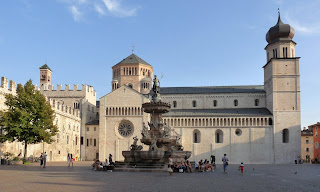Garibaldi-led force suffers heavy casualties but wins important victory
 |
| A depiction of the Battle of Bezzecca by the Venetian painter Felice Zennaro |
The battle was part of the Third Italian War of Independence as the new Kingdom of Italy, which had been formally proclaimed in 1861, sought to expel the Austrians from Venetia, which along with Papal Rome had remained outside the control of the fledgling nation.
It took place within the wider context of the Austro-Prussian War, a conflict that had begun earlier in the year after a territorial dispute. Italy, sensing an opportunity to annex Venetia and the part of Lombardy still under Austrian rule, had agreed an alliance with Prussia.
The Prussian victory at the Battle of Königgrätz resulted in Austria moving troops from Venetia towards Vienna, leaving their territories in northeastern Italy vulnerable to attack.
Giuseppe Garibaldi, who had famously led the initial push for Italian unification with his Expedition of the Thousand in 1860 and was now a general in the Royal Italian Army, took arms again as the head of another volunteer army known as the Hunters of the Alps, as the Kingdom of Italy sought to capitalise on this supposed Austrian weakness.
_-_Palerme._Portrait_de_Giuseppe_Garibaldi,_juillet_1860.jpg) |
| The Hunters of the Alps were under the command of Giuseppe Garibaldi |
Despite some setbacks, which had included Garibaldi himself being wounded in an assault on an enemy position, the Hunters of the Alps seized control of strategically important towns, opening two potential routes towards the ultimate goal of capturing the city of Trento.
As Garibaldi’s troops moved towards Riva del Garda, from which they intended to push north towards Trento, the Austrians occupied the town of Bezzecca in Val di Ledro, blocking the route.
Garibaldi, overseeing the battle from a coach because of his injuries, directed his artillery to secure a hill near the town to provide support for an infantry assault, which forced the Austrians to withdraw.
It was an Italian victory, albeit one with heavy casualties. Of the 15,500 deployed by Garibaldi, at least 120 were killed or declared missing presumed killed, a further 450 wounded and, before the Austrian withdrawal, more than 1,000 captured. This compared with only about 100 casualties in total on the Austrian side.
In the event, it was the last battle Garibaldi would need to fight before the Italian objective of bringing Venetia into the new kingdom was achieved.
 |
| General Alfonso La Marmora, who ordered Garibaldi to withdraw |
From the main square of Bezzecca, Giuseppe Garibaldi famously replied with a telegram consisting of just one word: “Obbedisco!" - "I obey!”
Under the terms of the Treaty of Vienna, which was signed on October 3, 1866, the Iron Crown of Lombardy, which had been in Austria’s possession since the fall of Napoleon Bonaparte in 1815, was returned to the Italian monarchy, while Venetia, consisting of modern Veneto, parts of Friuli and the city of Mantua, was ceded to Italy.
The annexation of Venetia and Mantua was subject to a plebiscite, allowing the population to express its will. The result was overwhelmingly in favour, with 99.9 percent of participants saying yes to becoming part of the Kingdom of Italy.
 |
| The Chiesa di Santi Stefano e Lorenzo houses a memorial to victims of the Battle of Bezzecca |
The Bezzecca of today, about 35km (22 miles) southwest of Trento, is a popular holiday destination in unspoilt surroundings, a short distance from Lago di Ledro, one of the most beautiful of the Trentino lakes. It is popular with walkers and cyclists, with many paths and trails to follow through the surrounding countryside. Since 2010, along with Pieve di Ledro, Concei, Molina di Ledro, Tiarno di Sopra and Tiarno di Sotto, it has been part of the new municipality of Ledro. The Battle of Bezzecca is recalled in many street names and buildings, while there is a small museum dedicated to Garibaldi and the Great War. Museum. In Piazza Garibaldi, the Chiesa di Santi Stefano e Lorenzo houses the Bezzecca War Memorial, which commemorates those who died fighting with Garibaldi and local men killed during the Great War. Outside the church, there is a 75 mm Italian cannon and a column donated to Bezzecca by the city of Rome in 1924.
 |
| Trento's Piazza Duomo, with the Palazzo Pretorio on the left and the Cattedrale di San Vigilio |
The prosperous modern city of Trento is considered one of the most desirable places to live in Italy for quality of life and employment opportunities. With a population of 117,000, it is situated in an Alpine valley on the Adige river between the northern tip of Lake Garda and the border city of Bolzano, about 95km (59 miles) north of Verona. Settled by the Romans in the first century, it changed hands many times before becoming a major city in the Holy Roman Empire. The Austrians took charge in the 14th century and it remained under their control, with the exception of a spell of French domination in the Napoleonic era until the First World War. It was notable in the 16th century for hosting the Council of Trent, the ecumenical council of the Catholic Church that gave rise to the resurgence of the church following Protestant Reformation. The 13th century Castello del Buonconsiglio, next to Trento’s city walls, was a military barracks under the Austrians, then a jail, before falling into disrepair. It was restored after Trento became part of Italy in the 1920s and now houses a museum and art gallery.
Also on this day:
1871: The birth of writer and historian Guglielmo Ferrero
1914: The birth of screenwriter Suso Cecchi D’Amico
1948: The birth of comedian-turned-activist Beppe Grillo
































